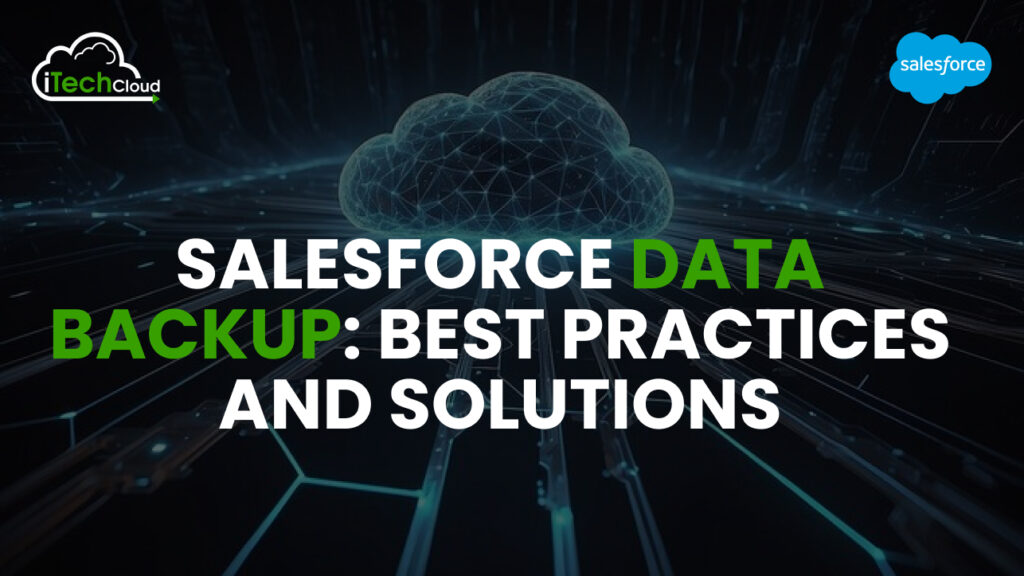Salesforce Data Backup: Best Practices and Solutions

In today’s digital era, Salesforce data is crucial in business operations, driving customer relationship management and informed decision-making. However, this data is susceptible to threats like accidental deletion, corruption, and cyberattacks. Implementing a Salesforce Data Backup strategy is essential to mitigate these risks, ensure regulatory compliance, and maintain operational continuity during unforeseen disasters.
Table of Contents
What is Salesforce Data Backup?
Salesforce Data Backup refers to creating and storing copies of your Salesforce data to ensure its safety, integrity, and recoverability. This process protects businesses from data loss due to accidental deletions, system errors, cybersecurity threats, or other unforeseen events.
Salesforce Data Backup involves the systematic replication of data such as accounts, contacts, opportunities, custom objects, and metadata configurations. This ensures that critical business information remains secure and recoverable, even in the event of a failure or mishap.
Why Is Salesforce Data Backup Important?
1. Data Loss Prevention:
Mistakes like accidental deletions or overwrites can result in significant losses. Backups provide a safety net to restore lost data.
2. Compliance Requirements:
Many industries have regulations that require businesses to maintain data integrity and ensure recoverability. Salesforce Data Backup supports compliance with such mandates.
3. Business Continuity:
Backups ensure that operations can continue without major disruptions during data restoration.
4. Protection Against Cyber Threats:
In cases of data breaches or ransomware, backups provide a fallback to recover the original data.
Best Practices for Salesforce Data Backup
Salesforce is a critical platform for managing customer data and processes, so ensuring reliable data backups is essential to protect against data loss, corruption, or accidental deletion.
Here are the best practices for Salesforce data backup:
1. Salesforce’s Native Backup Tools:
Salesforce provides native tools like the Data Export Service and Data Loader for manual or scheduled exports. These are a good starting point but may lack advanced features like incremental backups or rapid restoration.
2. Third-Party Backup Solutions:
Consider robust third-party backup solutions that offer automated, incremental backups and point-in-time recovery. These tools often come with additional features like compliance monitoring, encryption, and multi-region data storage.
3. Automate Backup Processes:
Automating backups reduces the risk of human error and ensures consistency. Use a predefined schedule to capture data and metadata changes regularly, ideally daily or weekly, depending on the frequency of updates.
4. Include Metadata in Backups:
Backup strategies should encompass both data (e.g., records) and metadata (e.g., custom objects, workflows, configurations). Losing metadata can disrupt workflows and require time-intensive manual restoration.
5. Follow the 3-2-1 Backup Rule:
Maintain three copies of your data: the primary Salesforce copy, a local backup, and a remote/cloud backup. This ensures redundancy and data availability in case of disasters or localized failures.
6. Backup Security:
Protect backups with encryption, access controls, and secure storage locations. Regularly audit who has access to backups to minimize the risk of unauthorized access.
7. Test Restore Processes:
Backups are only useful if you can restore data accurately and promptly. Conduct regular tests to validate the integrity of your backups and ensure restoration processes work as expected.
8. Document Your Backup Strategy:
Maintain detailed documentation of your backup schedule, tools, storage locations, and restoration procedures. This ensures clarity and quick action during emergencies.
9. Stay Compliant with Regulations:
Be aware of data protection laws like GDPR or HIPAA, and ensure your backup practices align with these requirements, especially regarding data storage and deletion.
10. Monitor and Optimize Backup Processes:
Regularly review backup logs and performance. Optimize schedules and storage usage based on data growth or changes in business requirements.
Types of Salesforce Data Backup
1. Full Data Backup:
A full backup captures all data and metadata within a Salesforce instance at a specific point in time. This comprehensive method is useful for disaster recovery but can be time-consuming and resource-intensive.
2. Incremental Data Backup:
Incremental backups save only the data that has changed since the last backup. This approach reduces storage requirements and processing time, making it efficient for frequent backups.
3. Metadata Backup:
Metadata backups focus on the configuration settings, code, workflows, and customizations in Salesforce. These are essential for restoring the structure of the Salesforce environment in case of corruption or misconfiguration.
4. Selective Data Backup:
This type involves backing up specific objects or records instead of the entire dataset. It is particularly useful for targeted recovery scenarios or when dealing with large data volumes.
Methods of Salesforce Data Backup
1. Salesforce Native Backup Solutions:
Salesforce provides built-in tools for data export and backup:
- Data Export Service: A manual or scheduled export of Salesforce data in CSV format. This tool is simple but requires additional storage and management outside of Salesforce.
- Report Exports: Users can export data by creating detailed reports, but this method is limited to certain object types and requires manual intervention.
- Weekly Export: Salesforce provides an automated weekly export feature for Enterprise and Unlimited editions, though the frequency may not meet real-time needs.
2. Third-Party Backup Tools:
External backup solutions integrate with Salesforce to automate backups, offering flexibility, scalability, and additional features such as encryption and compliance reporting. Examples include OwnBackup, Spanning, and Odaseva. These tools often support granular recovery and are suitable for businesses with complex requirements.
3. Custom Backup Solutions:
Organizations can develop custom scripts or use APIs to extract and store Salesforce data in external databases or cloud storage. This method provides high flexibility but requires technical expertise and maintenance.
4. On-Premises Backup:
Businesses can export Salesforce data and store it on local servers. While this method offers control over data storage, it may lack the scalability and redundancy of cloud-based solutions.
The future of Salesforce data backup
The future of Salesforce data backup is evolving rapidly, driven by increasing data volumes, stringent compliance requirements, and the growing reliance on Salesforce as a critical business system.
1. Automation:
Salesforce data backup services processes will become more automated, reducing manual effort and minimizing human error. This will involve automated backup scheduling, data validation, and recovery procedures.
2. Increased security:
Data encryption and security measures will be strengthened to protect sensitive information. This includes robust encryption algorithms, secure data transfer protocols, and access controls.
3. Improved recovery capabilities:
Faster and more efficient recovery processes will be developed to minimize downtime. This will involve advanced recovery techniques, such as granular recovery and point-in-time recovery, to restore specific data or configurations.
4. Integration with other SaaS applications:
Backup solutions will integrate seamlessly with other cloud-based tools used by organizations. This will enable comprehensive data protection for the entire IT ecosystem.
5. AI and machine learning:
AI-powered tools will be used to optimize backup schedules, identify anomalies, and automate recovery processes. This will improve efficiency and reduce the risk of data loss.
Conclusion:
Salesforce data backup is an essential practice for safeguarding critical business information. By implementing a reliable backup strategy, organizations can mitigate the risks of data loss due to accidental deletions, system failures, or cyberattacks. Regular backups ensure that data remains recoverable, minimizing downtime and operational disruption. Salesforce offers several backup options, including native tools like the Data Export feature and third-party applications. Prioritizing data protection helps maintain business continuity and compliance, giving organizations peace of mind knowing their valuable data is secure and recoverable in any unforeseen circumstances.

